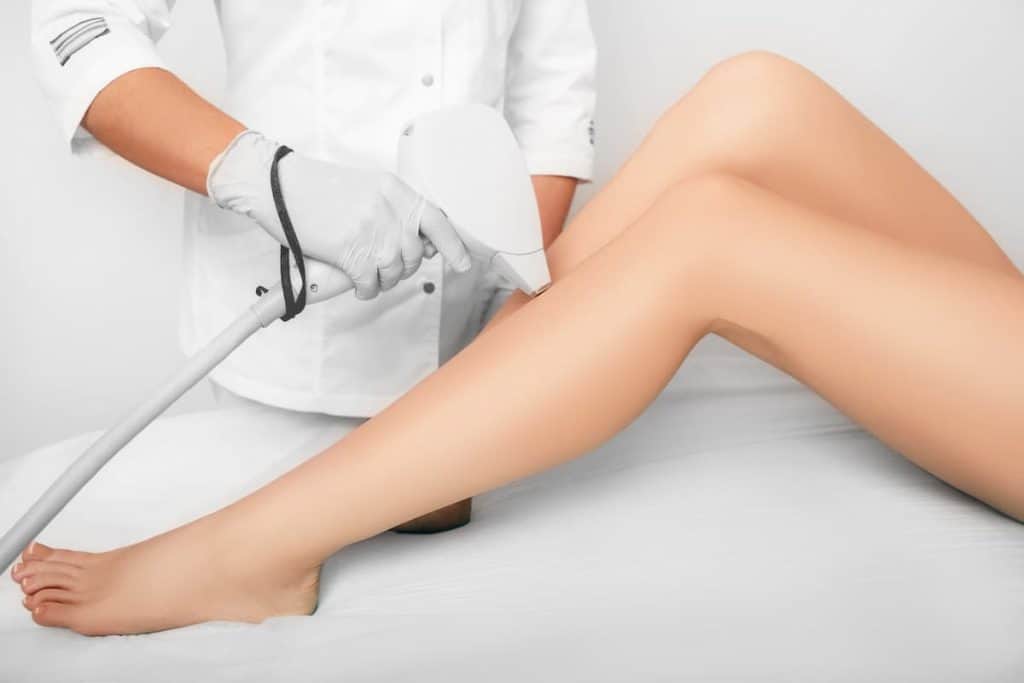Does Waxing Cause Ingrown Hairs? + Alternative Hair Removal Methods
This post may contain affiliate links, which means I may receive a small commission, at no cost to you, if you make a purchase.
Waxing is one of the beauty industry’s most popular hair removal methods.
This technique is ideal if you’re looking for an affordable, safe, and quick process to remove hair on any part of the body—from the legs, arms, back, downstairs bits, you name it!

Beauty enthusiasts opt for this hair removal technique as it can smoothen and exfoliate the skin, improve skin texture, and ensure finer, lighter, and softer hair regrowth.
But if we set all the waxing benefits aside, an important question remains – does waxing cause ingrown hairs?
The quick answer to that question is that, just like other hair removal methods, waxing may cause ingrown hair due to various factors (more of this later!)
However, you can do something to reduce the chance of getting ingrown hair after hair waxing!
In this piece, we’ll take a closer look and discover what waxing is, how waxing can cause ingrown hair and ways to prevent this from happening.
Table of Contents
- 1 What Is Waxing?
- 2 Hair Waxing Process
- 3 What Are Ingrown Hairs?
- 4 Signs that You Have Ingrown Hairs
- 5 Factors That Can Cause Ingrown Hair
- 6 Can Waxing Cause Ingrown Hair? An Ongoing Discussion
- 7 How Waxing Can Potentially Cause Ingrown Hair
- 8 Dos and Don’ts to Avoid Ingrown Hair
- 9 Alternative Hair Removal Methods That Can Prevent Ingrown Hair
- 10 Frequently Asked Questions
- 11 The Verdict: Waxing Can Cause Ingrown Hairs
- 12 Authors
What Is Waxing?
Waxing is a semi-permanent hair removal technique that involves lifting and removing the hair from the root. Once this is done, a new hair usually takes three to eight weeks to grow.
Unlike other hair removal methods, like sugaring and threading, which focus on specific areas, you can wax any body part. These may include feet, bikini area, face, abdomen, eyebrow, back, legs, and arms.
Hair Waxing Process
Let’s take a look at the waxing process when done professionally with the help of a certified esthetician:
- The process begins with cleaning the area to be waxed.
- The esthetician will apply a thin layer of talcum powder to the area to absorb any oils or moisture from the skin. This will help the wax to adhere better to the hair.
- Next, the esthetician will heat the wax, either with a wax warmer or by microwaving, and will test the wax temperature on the inside of the wrist to ensure it’s not too hot.
- The wax will be applied with a wooden spatula to the skin in the direction of hair growth.
- Then a strip of cloth or paper is immediately placed over the wax and pressed down firmly.
- The esthetician will then pull the strip of cloth or paper in the opposite direction of hair growth, removing the wax and hair from the skin.
- This process is repeated multiple times until all unwanted hair is removed.
After waxing, the esthetician may apply a soothing lotion or oil to the skin to reduce redness and irritation and share post-wax care reminders.
It’s best to avoid sun exposure, tight clothing, and hot showers for at least 24 hours after waxing.
It’s also important to note that waxing can be painful, especially for those with sensitive skin.
So, it’s best to consult your trusted esthetician before the process and ask them to use low-temperature wax or apply a numbing cream to reduce pain and discomfort if needed.
Waxing can also be done at home with home waxing kits, like this home waxing kit, but the process is relatively the same as above.
What Are Ingrown Hairs?
Ingrown hairs are a skin condition that happens when hair grows sideways or curls back into the skin rather than growing out of the skin’s surface.
Commonly, ingrown hair happens after hair removal methods such as plucking, shaving, or waxing. However, they may also occur naturally.
Moreover, ingrown hairs usually appear on areas of the body where the hair is frequently removed but can appear anywhere on the body where hair grows.
Signs that You Have Ingrown Hairs
Not sure if you have ingrown hair?
Here’s how to spot them:
- The area looks irritated and red
- The area is a bit inflamed or swollen
- Ingrown hair may or may not itch
- The area may or may not feel warm
- They can sometimes appear as red, small bumps on the skin
- They can be painful
- They can sometimes occur with a pus-filled blister
Fortunately, ingrown hairs can be treated with over-the-counter creams or lotions containing salicylic acid or alpha hydroxy acid. They can also be treated by gently exfoliating the skin.

In some cases, the ingrown hair cannot be extracted if the skin is infected. In this case, you may need to consult a doctor or a board-certified dermatologist.
Factors That Can Cause Ingrown Hair
Ingrown hairs may be caused by a variety of factors, some of which include:
Hair Removal Methods
Improper hair removal techniques, such as shaving too closely, using dull blades, or not correctly exfoliating the skin before hair removal, can increase the risk of ingrown hairs.
Hair Type
People with curly or coarse hair may be more prone to developing ingrown hairs as this type of hair is more likely to curl back into the skin.
Dead skin cells
Dead skin cells can block hair follicles and cause the hair to grow back into the skin.
Genetics
Some people are genetically predisposed to developing ingrown hairs. If it happens regularly, you may be one of them.
Hormones
Hormonal changes can affect the hair growth cycle and make some people more prone to ingrown hair.
Skin Conditions
People with certain skin conditions, such as eczema or psoriasis, may be more susceptible to developing ingrown hairs.
Certain Skincare Practices
Using heavy and oily creams, lotions, or cosmetics or using harsh scrubs or exfoliants can clog the pores and cause ingrown hairs.
Clothing
Wearing very tight clothes can trap the hair and cause it to grow back into the skin.
Improper hygiene
Not keeping the skin clean and dry can also contribute to the development of ingrown hairs.
These are just some causes of ingrown hair. It’s important to note that everyone’s skin is different, and what causes ingrown hair in one person may not work for another.
Understanding the reason you get ingrown hair will help you understand how to address them.
It’s good to have a personalized skincare routine and consult a dermatologist or skincare professional if you have any concerns.
Can Waxing Cause Ingrown Hair? An Ongoing Discussion
There is an ongoing discussion about whether waxing causes ingrown hairs.
Some claim that waxing increases the risk of ingrown hairs, while others argue that waxing doesn’t necessarily cause ingrown hair.
One argument in favor of waxing causing ingrown hairs emphasizes that when hair is waxed, the hair is removed from the root, which can lead to the hair growing back in a curved shape.
As a result, the hair becomes trapped under the skin, leading to ingrown hair.
Additionally, some argue that waxing can cause irritation and inflammation in the hair follicle, which can also contribute to the formation of ingrown hairs.
On the other hand, some argue that waxing does not cause ingrown hairs and say that ingrown hairs are caused by other factors such as improper hair removal techniques, dead skin cells blocking the hair follicle, and genetics.
They also point out that ingrown hairs can occur with any hair removal method, not just waxing, so it’s not right to say waxing is what causes them.
It’s important to remember that the risk of ingrown hairs from waxing may vary depending on several factors, including the individual’s skin type, hair type, hair removal technique, and more.
How Waxing Can Potentially Cause Ingrown Hair
As mentioned earlier, waxing may cause ingrown hairs in some individuals.
How does that happen? Let’s look closer.
When waxing, the hair is pulled out from the root. But if the hair is not pulled out completely or if the hair is too short, it will likely grow back into the skin.
Furthermore, if the wax is too hot or the skin is not adequately exfoliated before waxing, it can cause irritation and inflammation, which can lead to the formation of ingrown hairs.
Note, as mentioned previously, people with coarse or curly hair may also be more susceptible to ingrown hairs because of the nature and texture of their hair.
However, not everyone who waxes will develop ingrown hairs.
So, if you’re planning to wax any area of your body, it is essential to take proper care of your skin before and after waxing.
Some ways you can do that include exfoliating and using gentle skin care products, choosing a certified esthetician who uses the correct technique when applying wax, and using soothing lotions or creams after waxing.
If you are experiencing recurrent ingrown hairs or it’s causing you discomfort after your waxing sessions, it’s a good idea to consult a professional or a dermatologist for personalized advice.
Dos and Don’ts to Avoid Ingrown Hair
Here are some dos and don’ts to help prevent ingrown hairs while waxing:
Do’s:
- Exfoliate the skin before waxing to remove dead skin cells and unclog hair follicles.
- Apply talcum powder before waxing to absorb moisture and make the hair stand up.
- Apply the wax in the direction of hair growth.
- Remove the strip quickly in the opposite direction of hair growth, pulling as close to the skin as possible.
- Moisturize the skin after waxing to reduce redness and irritation.
- Avoid sun exposure, exfoliating, or using scrubs for 24 hours after waxing to prevent irritation.
Don’ts:
- Don’t wax over skin that is irritated or sunburned
- Don’t use wax that is too hot, as it can burn the skin
- Don’t wax over the same area multiple times, as it can cause irritation and increase the likelihood of ingrown hairs.
- Don’t pick or squeeze ingrown hairs, which can cause infection and inflammation.
- Don’t use scrubs or exfoliants immediately after waxing, as they can irritate the skin.
Remember that everyone’s skin is different, and some may be more sensitive to waxing than others. If you notice any signs of infection, such as redness, swelling, or discharge, seek medical attention.
Alternative Hair Removal Methods That Can Prevent Ingrown Hair
If you don’t want to risk getting ingrown hairs from waxing or if your skin is too sensitive for waxing, there are some alternative hair removal methods that you can try.
These include the following:
Laser Hair Removal

This process uses a laser to damage the hair follicles, reducing or eliminating hair growth over time. It is an effective method of hair removal, but it can be costly and may require multiple treatments.
Electrolysis
This method uses an electrical current to damage the hair follicles, reducing or eliminating hair growth.
Electrolysis is suitable for all hair and skin types. But similar to laser hair removal, it can be pricey and may require multiple treatments.
Depilatory Creams
This hair removal technique involves using creams/lotions that contain chemicals to dissolve the hair above the skin’s surface.
Depilatory creams, such as Veet Sensitive Hair Remover Gel Cream, are a good alternative for sensitive skin and are not as painful as other methods.
However, some people may have an allergic reaction to the chemicals in the creams, so it’s important to patch-test the product on a small area of the skin first.
Threading
This method uses twisted thread to remove hair from the root. It’s gentle on the skin and can be precise.
But it’s less effective for large areas than other methods and might be more painful than other hair removal methods.
Sugaring
Sugaring or sugar waxing uses a paste made from sugar, lemon, and water to remove hair from the root. It’s similar to waxing, but it’s less painful and less likely to cause ingrown hairs.
NOTE: Hair removal methods like laser hair removal and electrolysis may not prevent ingrown hairs 100%, but they have a lower chance of causing ingrown hairs than other methods like shaving or waxing.
By doing sugar waxing, you’re basically clearing out any skin cells or dirt that keeps your hair from growing normally. As a result, it prevents ingrown hairs from forming.
It’s also worth mentioning that not all hair removal methods work for everyone, so it’s essential to consult a professional or research before trying a new hair removal method.
Frequently Asked Questions
Does waxing remove ingrown hairs?
Ingrown hairs occur when hair cannot break through the skin’s surface and instead grows back into the skin. Hence, waxing ingrown hairs doesn’t really work.
Waxing may be able to remove the hair, but it may not address the underlying cause of the ingrown hair.
The best thing to do is to exfoliate the skin before and after hair removal to help prevent ingrown hairs.
Does waxing cause more ingrown hairs than shaving?
Waxing and shaving are two common types of hair removal.
At this point, you may ask: “Is waxing better for ingrown hairs? Or “Does waxing make ingrown hairs worse than shaving?
Waxing can cause ingrown hairs in some people, but it is not necessarily more likely to cause them than shaving.
Both methods of hair removal can lead to ingrown hairs if the hair is not properly cared for after removal.
Aside from regularly exfoliating the skin, you can also reduce the risk of ingrown hairs if you avoid shaving or waxing over the same area too frequently.
Make sure the hair is removed entirely during waxing for the best results!
If you experience ingrown hairs regularly after waxing or shaving, you should consult a dermatologist for advice on managing them.
The Verdict: Waxing Can Cause Ingrown Hairs
Ingrown hairs can be caused by various factors, including improper hair removal techniques, dead skin cells blocking the hair follicle, and genetics.
People with curly or coarse hair may be more prone to developing ingrown hairs, as the hair is more likely to curl back into the skin.

People with sensitive skin or conditions such as eczema may also be more susceptible to ingrown hairs.
Regardless of these factors, the potential risk of having ingrown hair after waxing is more likely to happen if you don’t know how to wax your hair.
So, if you want to avoid these and minimize the chances of getting ingrown hairs, booking a certified esthetician trained to do hair waxing is the best option.
If you do it properly, you can still wax and get fantastic results without ingrown hair.


